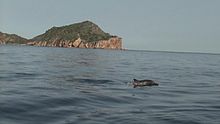Sotalia guianensis
| Guiana dolphin | |
|---|---|
 |
|
| Guiana dolphin in Mochima National Park | |
 |
|
| Size compared to an average human | |
| Scientific classification | |
| Kingdom: | Animalia |
| Phylum: | Chordata |
| Class: | Mammalia |
| Order: | Artiodactyla |
| Infraorder: | Cetacea |
| Family: | Delphinidae |
| Genus: | Sotalia |
| Species: | S. guianensis |
| Binomial name | |
|
Sotalia guianensis (van Bénéden, 1864) |
|
 |
|
| Range of Guiana dolphin(coastal–solid pattern) and tucuxi (inland–hatched pattern) | |
The Guiana dolphin (Sotalia guianensis), also known as the estuarine dolphin, is a dolphin found in the coastal waters to the north and east of South America, and east of Central America. It is a member of the oceanic dolphin family (Delphinidae).
During its 2008 Annual Meeting in Santiago, Chile, as proposed by Flores et al. (2008), the Scientific Committee of the International Whaling Commission (IWC) endorsed ‘Guiana dolphin’ as the common English name for (Sotalia guianensis) in its IWC List of Recognized Cetacean Species (LRCS). Furthermore, the common name "Guiana dolphin" has been suggested by Flores and colleagues.
The Guiana dolphin (Sotalia guianensis) is frequently described as looking similar to the bottlenose dolphin. However, it is typically smaller, at only up to 2.1 m (6.9 ft) in length. The dolphin is coloured light to bluish grey on its back and sides. The ventral region is light grey. The dorsal fin is typically slightly hooked, with a triangular shape. The beak is well-defined and of moderate length.
Guiana dolphins are very inconspicuous, and considered a "shy" species. It does not bow ride on boats and normally swims away from them.
Researchers have recently shown that the costero has an electroreceptive sense, and speculate this may also be the case for other odontocetes.
Although described as species distinct from the tucuxi Sotalia fluviatilis by Pierre-Joseph van Bénéden in 1864, the costero Sotalia guianensis has subsequently been synonymized with Sotalia fluviatilis with the two species being treated as subspecies, or marine and freshwater varieties. The first to reassert differences between these two species was a three-dimensional morphometric study of Monteiro-Filho and colleagues. Subsequently a molecular analysis by Cunha and colleagues unambiguously demonstrated that Sotalia guianensis was genetically differentiated from Sotalia fluviatilis. This finding was reiterated by Caballero and colleagues with a larger number of genes. The existence of two species has been generally accepted by the scientific community;.
The costero is found close to estuaries, inlets and other protected shallow-water areas around the eastern and northern South American coast. It has been reported as far south as southern Brazil and north as far as Nicaragua. One report exists of an animal reaching Honduras.
...
Wikipedia

